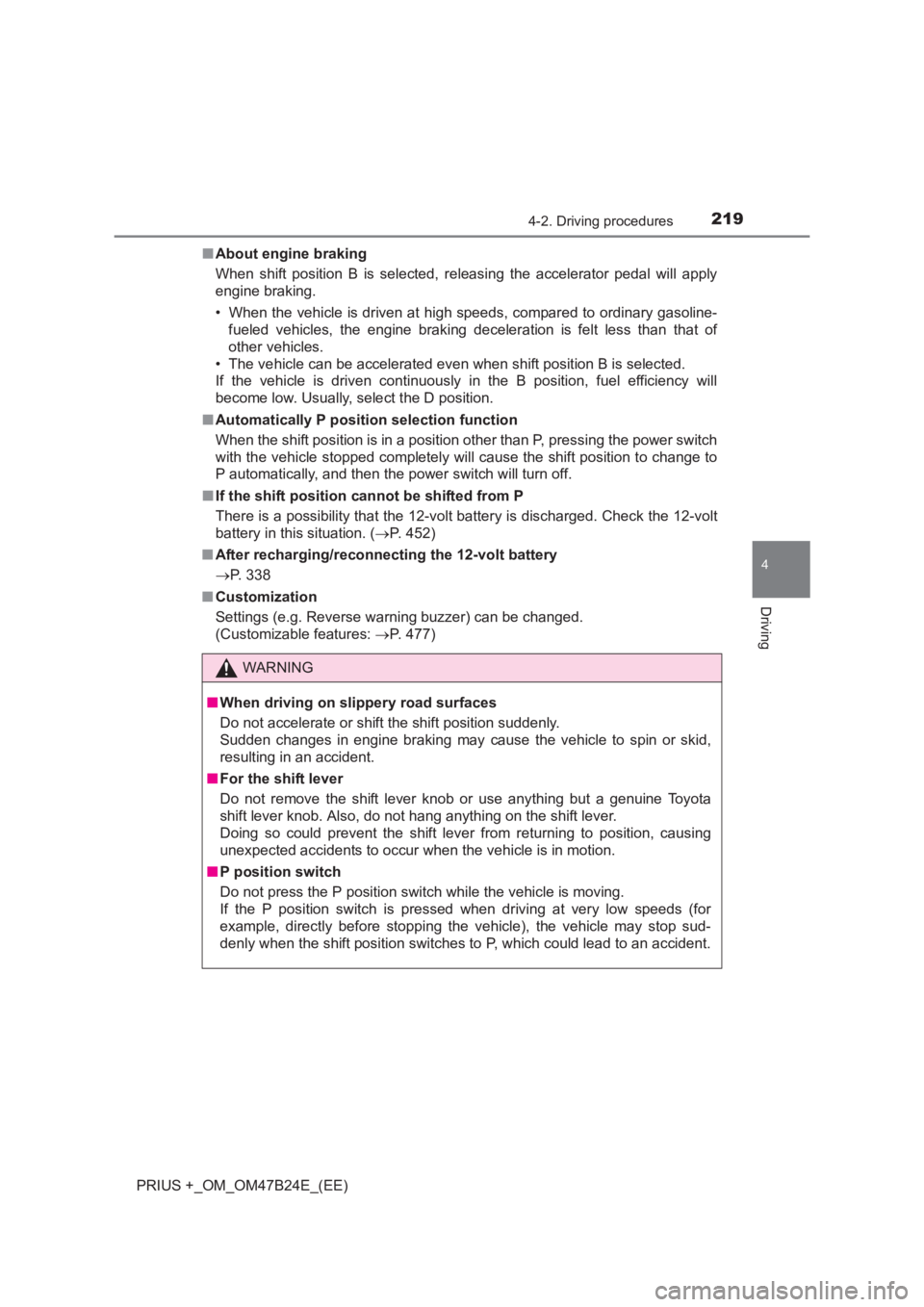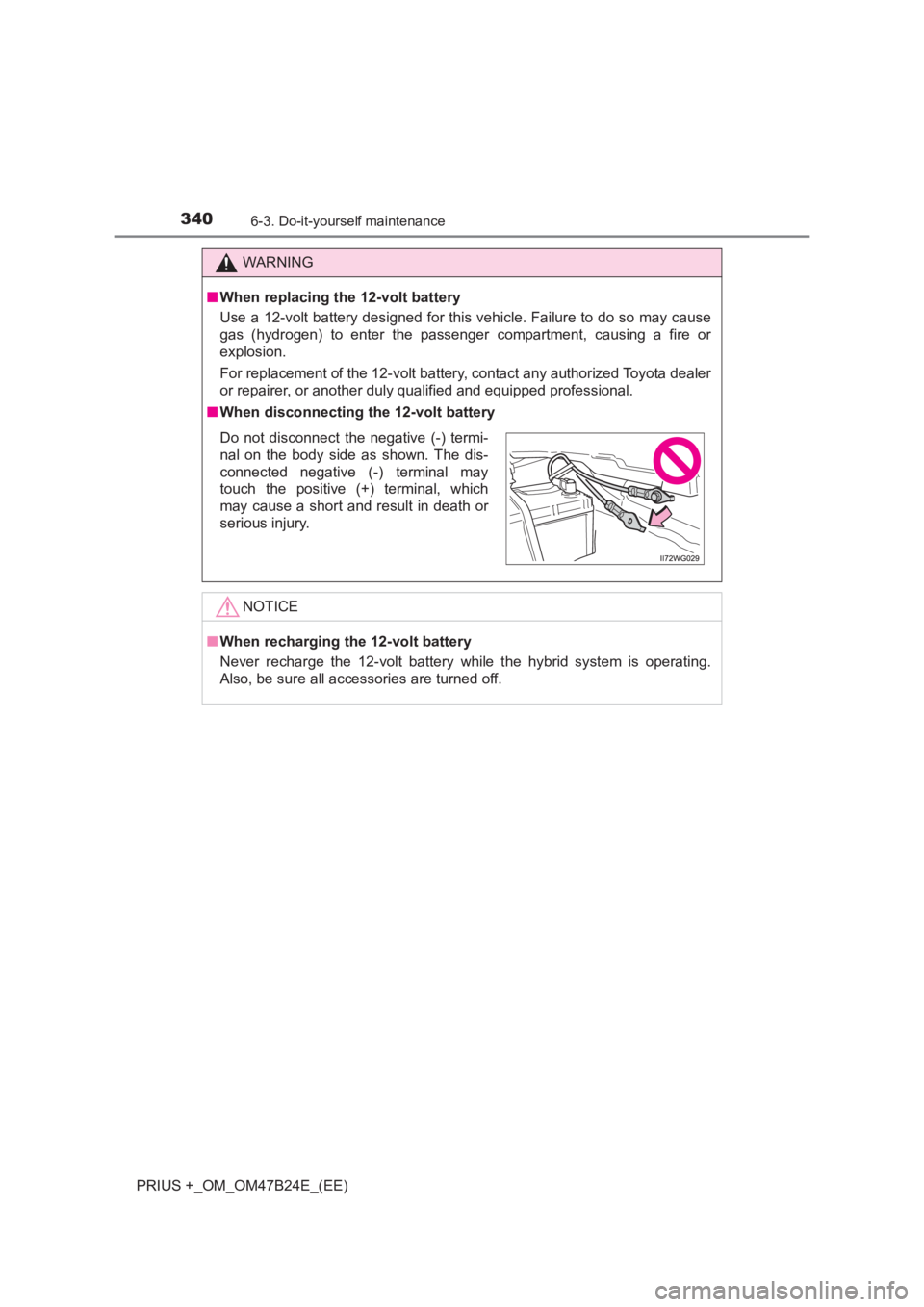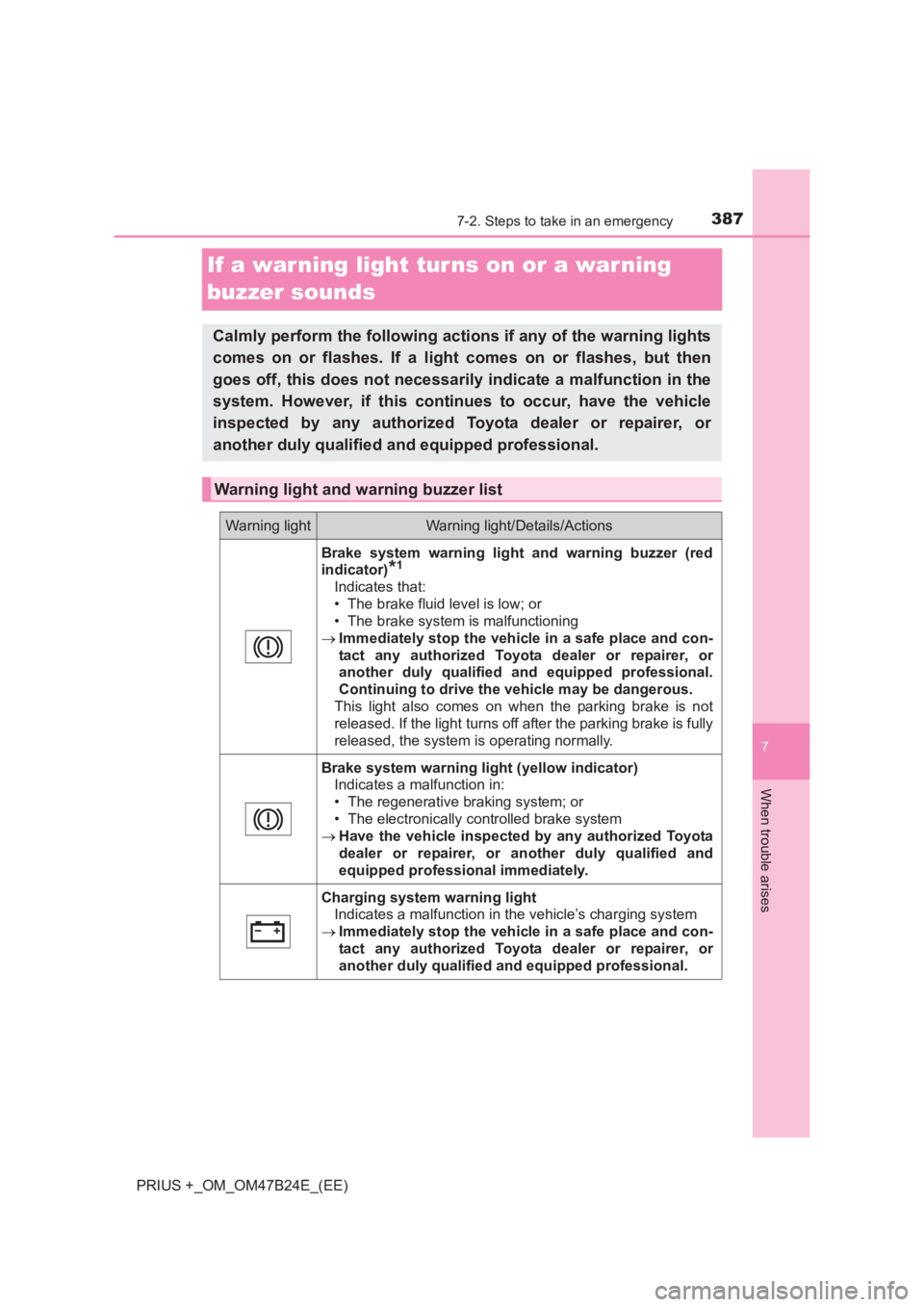2017 TOYOTA PRIUS PLUS charging
[x] Cancel search: chargingPage 219 of 509

2194-2. Driving procedures
4
Driving
PRIUS +_OM_OM47B24E_(EE)■
About engine braking
When shift position B is selected, rel easing the accelerator pedal will apply
engine braking.
• When the vehicle is driven at high speeds, compared to ordinary gasoline- fueled vehicles, the engine braking deceleration is felt less than that of
other vehicles.
• The vehicle can be accelerated even when shift position B is selected.
If the vehicle is driven continuously in the B position, fuel efficiency will
become low. Usually, select the D position.
■ Automatically P position selection function
When the shift position is in a position other than P, pressing the power switch
with the vehicle stopped completely will cause the shift position to change to
P automatically, and then the power switch will turn off.
■ If the shift position cannot be shifted from P
There is a possibility that the 12-volt battery is discharged. Check the 12-volt
battery in this situation. ( →P. 452)
■ After recharging/reconnecting the 12-volt battery
→ P. 338
■ Customization
Settings (e.g. Reverse warning buzzer) can be changed.
(Customizable features: →P. 477)
WARNING
■ When driving on slippery road surfaces
Do not accelerate or shift the shift position suddenly.
Sudden changes in engine braking may cause the vehicle to spin or skid,
resulting in an accident.
■ For the shift lever
Do not remove the shift lever knob or use anything but a genuine Toyota
shift lever knob. Also, do not hang anything on the shift lever.
Doing so could prevent the shift lever from returning to position, causing
unexpected accidents to occur when the vehicle is in motion.
■ P position switch
Do not press the P position switch while the vehicle is moving.
If the P position switch is pressed when driving at very low speeds (for
example, directly before stopping the vehicle), the vehicle may stop sud-
denly when the shift position switches to P, which could lead to an accident.
Page 220 of 509

2204-2. Driving procedures
PRIUS +_OM_OM47B24E_(EE)NOTICE
■
Hybrid battery (tract ion battery) charge
If the shift position is in N, the hybrid battery (traction battery) will not be
charged. To help prevent the battery from discharging, avoid leaving the N
position selected for an extended period of time.
■ Situations where shift control system malfunctions are possible
If any of the following situations occurs, shift control system malfunctions
are possible.
Immediately stop the vehicle in a safe place on level ground, apply the park-
ing brake, and then contact any authorized Toyota dealer or repairer, or
another duly qualified and equipped professional.
● Vehicles without multi-information display:
When the “WHEN PARKING, APPLY PARKING BRAKE SECURELY”
warning message appears on the instrument cluster. ( →P. 390)
● Vehicles without multi-information display:
When the parking lock system warning light is illuminated.
● Vehicles with multi-information display:
When the warning message indicating the shift control system appears on
the multi-information display. ( →P. 402)
● When everything except the shift position indicator selection frame is illu-
minated.
● When the shift position indicator remains off.
■ Notes regarding shift lever and P position switch operation
Avoid repeatedly operating the shift lever and P position switch in quick suc-
cession.
The system protection function may activate and it will not be temporarily
possible to shift the shift position other than P. If this happens, please wait
for approximately 20 seconds before attempting to change the shift position
again.
Page 338 of 509

3386-3. Do-it-yourself maintenance
PRIUS +_OM_OM47B24E_(EE)
The meanings of each caution symbol on the top of the 12-volt battery
are as follows:
■Before recharging
When recharging, the 12-volt battery produces hydrogen gas which is flam-
mable and explosive. Therefore, obser ve the following precautions before
recharging:
● If recharging with the 12-volt battery installed on the vehicle, be sure to dis-
connect the ground cable.
● Make sure the power switch on the charger is off when connecting and dis-
connecting the charger cables to the 12-volt battery.
■ After recharging/reconnecting the 12-volt battery
●Unlocking the doors using the smart entry & start system may not be possi-
ble immediately after reconnecting the 12-volt battery. If this happens, use
the wireless remote control or the mechanical key to lock/unlock the doors.
● Start the hybrid system with the pow er switch in ACCESSORY mode. The
hybrid system may not start with the power switch turned off. However, the
hybrid system will operate normally from the second attempt.
● The power switch mode is recorded by the vehicle. If the 12-volt battery is
reconnected, the vehicle will return the power switch mode to the status it
was in before the 12-volt battery was disconnected. Make sure to turn off
the power before disconnect the 12-volt battery. Take extra care when con-
necting the 12-volt battery if the power switch mode prior to discharge is
unknown.
● Restart the hybrid system, depress the brake pedal, and confirm that it is
possible to shift into each shift position.
If the system will not start even after multiple attempts at all methods above,
contact any authorized Toyota dealer or repairer, or another duly qualified and
equipped professional.
Caution symbols
No smoking, no naked
flames, no sparksBattery acid
Shield eyesNote operating
instructions
Keep away from
childrenExplosive gas
Page 340 of 509

3406-3. Do-it-yourself maintenance
PRIUS +_OM_OM47B24E_(EE)
WARNING
■ When replacing the 12-volt battery
Use a 12-volt battery designed for this vehicle. Failure to do so may cause
gas (hydrogen) to enter the passenger compartment, causing a fire or
explosion.
For replacement of the 12-volt battery, contact any authorized Toyota dealer
or repairer, or another duly qualified and equipped professional.
■ When disconnecting the 12-volt battery
NOTICE
■When recharging the 12-volt battery
Never recharge the 12-volt battery while the hybrid system is operating.
Also, be sure all accessories are turned off.
Do not disconnect the negative (-) termi-
nal on the body side as shown. The dis-
connected negative (-) terminal may
touch the positive (+) terminal, which
may cause a short and result in death or
serious injury.
Page 387 of 509

3877-2. Steps to take in an emergency
PRIUS +_OM_OM47B24E_(EE)
7
When trouble arises
If a war ning light tur ns on or a warning
buzzer sounds
Calmly perform the following actions if any of the warning lights
comes on or flashes. If a light comes on or flashes, but then
goes off, this does not necessarily indicate a malfunction in the
system. However, if this continues to occur, have the vehicle
inspected by any authorized Toyota dealer or repairer, or
another duly qualified and equipped professional.
Warning light and warning buzzer list
Warning lightWarning light/Details/Actions
Brake system warning light and warning buzzer (red
indicator)
*1
Indicates that:
• The brake fluid level is low; or
• The brake system is malfunctioning
→ Immediately stop the vehicle in a safe place and con-
tact any authorized Toyota dealer or repairer, or
another duly qualified and equipped professional.
Continuing to drive the vehicle may be dangerous.
This light also comes on when the parking brake is not
released. If the light turns off after the parking brake is fully
released, the system is operating normally.
Brake system warning light (yellow indicator) Indicates a malfunction in:
• The regenerative braking system; or
• The electronically controlled brake system
→ Have the vehicle inspected by any authorized Toyota
dealer or repairer, or another duly qualified and
equipped professional immediately.
Charging system warning light Indicates a malfunction in the vehicle’s charging system
→ Immediately stop the vehicle in a safe place and con-
tact any authorized Toyota dealer or repairer, or
another duly qualified and equipped professional.
Page 390 of 509

3907-2. Steps to take in an emergency
PRIUS +_OM_OM47B24E_(EE)
(If equipped)
Parking lock system warning message (warning buzzer)Indicates a malfunction in the shift control system when
the vehicle is stopped
• In this situation, there is a possibility that the parkinglock mechanism will not work. When parking, park the
vehicle on a flat surface and apply the parking brake
securely.
• The power switch may not be turned off. If this happens,
applying the parking brake will enable the switch to be
turned off.
→ Have the vehicle inspected by any authorized Toyota
dealer or repairer, or another duly qualified and
equipped professional immediately.
(If equipped)
Hybrid battery indicator light The hybrid battery (traction battery) will soon need to be
inspected or replaced
Have the hybrid battery (traction battery) inspected by any
authorized Toyota dealer or re pairer, or another duly quali-
fied and equipped professional immediately.
*2
→ Have the vehicle inspected by any authorized Toyota
dealer or repairer, or another duly qualified and
equipped professional immediately.
(If equipped)
LED headlight warning light Indicates a malfunction in the LED headlights
The LED headlights will not normally illuminate when
there is a malfunction, however they may be able to illu-
minate depending on the nature of the problem.
→ Have the vehicle inspected by any authorized Toyota
dealer or repairer, or another duly qualified and
equipped professional immediately.
(Flashes)
(If equipped)
P position request indicator light (warning buzzer)
The amount of charge remaining in the hybrid battery
(traction battery) has fallen because the shift position has
been left in N for a long time
→ Because recharging is not possible when the shift
position is in N, shift the shift position to P when
parking the vehicle for a long time.
• The driver’s door has been opened while the shift posi- tion is in N, D or B
• An attempt has been made to start the hybrid system
while the shift position is in anything other than P
→ Shift the shift position to P.
Warning lightWarning light/Details/Actions
Page 391 of 509

3917-2. Steps to take in an emergency
PRIUS +_OM_OM47B24E_(EE)
7
When trouble arises
(If equipped)
Hybrid system overheat warning light (warning buzzer)The hybrid system has overheated
This light may come on when driving under severe operat-
ing conditions, and the output of the hybrid system may
temporarily decrease in order to protect the system. (For
example, when driving up a long steep hill or driving up a
steep hill in reverse.)
→ Stop and check. ( →P. 457)
(If equipped)
Cruise control indicator (yellow indicator)
Indicates a malfunction in the cruise control
→ Have the vehicle inspected by any authorized Toyota
dealer or repairer, or another duly qualified and
equipped professional immediately.
(Only outer frame flashes)
(If equipped)
Low hybrid battery (traction battery) warning light
(warning buzzer)
Hybrid battery (traction battery) level becomes low
because the shift position is in N for long time
→ Because recharging is not possible when the shift
position is in N, shift the shift position to P when
parking the vehicle for a long time.
High coolant temperature warning light
Changes from a flashing to a solid light when the engine
coolant temperature increases
→ Immediately stop the vehicle in a safe place.
(→ P. 457)
Automatic headlight leveling system warning light
Indicates a malfunction in the automatic headlight leveling
system
→ Have the vehicle inspected by any authorized Toyota
dealer or repairer, or another duly qualified and
equipped professional immediately.
Open door warning light (warning buzzer)*3
Indicates that a door is not fully closed
→ Check that all the doors are closed.
Low fuel level warning light
Indicates that remaining fuel is approximately 6.0 L (1.6
gal., 1.3 Imp.gal.) or less
→ Refuel the vehicle.
Warning lightWarning light/Details/Actions
Page 406 of 509

4067-2. Steps to take in an emergency
PRIUS +_OM_OM47B24E_(EE)
An attempt was made to change the shift position
to R while the vehicle was moving forward. A buzzer also sounds.
The shift position automatically changed to N.
→ Stop the vehicle, and then change the shift
position.
Indicates that the P position switch is pressed
while the vehicle is running.
A buzzer also sounds.
The shift position automatically changed to N.
→ To shift the shift position to P, stop the
vehicle completely and press the P posi-
tion switch.
→ To continue driving, shift the shift position
to D or R.
Insufficient 12-volt battery charge
The parking lock mechanism may not function.
The hybrid system may not be able to start.
The power switch may not be able to be turned
off. In this case, the power switch may be
turned off by applying the parking brake.
After charging the 12-volt battery, the message
may continue to be displayed until the shift
position is changed from P.
A buzzer also sounds.
→ When parking, choose a level location and
apply the parking brake securely.
→ Maintain the hybrid system operation state
for approximately 15 minutes or more to
recharge the 12-volt battery.
→ The hybrid system will not start: Start the
hybrid system by following the “If the
12-volt battery is discharged” procedure
(→ P. 452).
→ If the message does not disappear: The
12-volt battery may be deteriorating.
The 12-volt battery may be discharged if
this continues. Have the 12-volt battery
inspected at any auth orized Toyota dealer
or repairer, or another duly qualified and
equipped professional.
Warning messageDetails/Actions
(Flashes)
(Flashes)